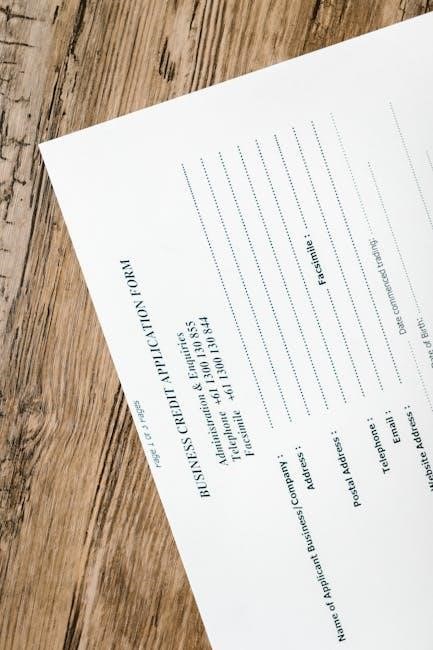Form 8915-F is used to report qualified disaster retirement plan distributions and repayments, specifically for disasters declared after 2019, including coronavirus-related distributions, to the IRS.
1.1 Purpose of Form 8915-F
Form 8915-F is designed to report qualified disaster retirement plan distributions and repayments to the IRS, specifically for events declared after 2019, including coronavirus-related distributions. Its primary purpose is to detail the amounts taken from retirement accounts under special circumstances, such as natural disasters or the COVID-19 pandemic, allowing individuals to avoid early withdrawal penalties. The form also tracks repayments made back into retirement accounts, ensuring compliance with tax rules and providing a clear record of financial transactions related to these events. It serves as a crucial document for accurately reporting these unique financial situations to the IRS.
1.2 Recent Updates to Form 8915-F
The IRS has recently updated Form 8915-F to reflect changes in qualified disaster provisions and improve clarity. The revised form now accommodates distributions for disasters declared after 2019, including coronavirus-related relief. Additionally, the instructions have been expanded to cover repayment details and ensure compliance with updated tax regulations. The form now includes specific sections for reporting distributions and repayments, making it easier for filers to navigate and complete accurately. These updates aim to streamline the reporting process and ensure individuals affected by disasters can properly document their financial transactions with the IRS. The latest version is essential for those seeking tax relief under these circumstances.

Eligibility Criteria for Using Form 8915-F
Form 8915-F is for individuals impacted by qualified disasters, including coronavirus-related events, occurring after 2019, to report distributions and repayments from retirement plans.
2.1 Qualified Disaster Distributions
Qualified disaster distributions are withdrawals from retirement plans made due to a qualified disaster declared after 2019 or coronavirus-related events. These distributions must be reported using Form 8915-F, which allows individuals to document withdrawals and repayments. The IRS sets a limit of $22,000 per disaster, enabling individuals to manage their financial recovery without immediate tax burden. Form 8915-F is crucial for compliance with tax regulations and for taking advantage of repayment provisions. Accurate and timely reporting ensures proper tax filings and maintains eligibility for repayment options, helping individuals navigate financial challenges smoothly and avoid potential penalties.
2.2 Coronavirus-Related Distributions
Coronavirus-related distributions are specific withdrawals from retirement accounts made in response to the COVID-19 pandemic. These distributions are eligible for reporting on Form 8915-F, allowing individuals to document the amounts taken and any repayments made. The IRS has streamlined the process, ensuring that these distributions are treated differently from regular withdrawals, with provisions for tax deferral and penalty relief. Form 8915-F is essential for accurately reporting these distributions and repayments, ensuring compliance with IRS guidelines and maximizing the benefits available under the CARES Act. Proper documentation and timely filing are crucial to avoid penalties and maintain the integrity of retirement accounts.
2.3 Other Qualified Disasters
Beyond coronavirus-related distributions, Form 8915-F also applies to other qualified disasters declared by the federal government. These include natural disasters such as hurricanes, wildfires, floods, and earthquakes occurring in 2020 or later. The IRS specifies that distributions made in response to these events are eligible for reporting on Form 8915-F. The form ensures that individuals can document withdrawals and repayments related to these disasters, benefiting from tax relief and penalty waivers. It is crucial to verify the IRS list of qualified disasters to determine eligibility. Proper reporting on Form 8915-F helps maintain accurate records and ensures compliance with tax regulations, providing financial relief to those affected by such events.

Key Features and Benefits of Form 8915-F
Form 8915-F offers tax-deferred growth opportunities, relief from early withdrawal penalties, and an extended repayment period for qualified disaster distributions, up to $22,000 per disaster.
3.1 Extended Repayment Period
Form 8915-F allows taxpayers to benefit from an extended repayment period for qualified disaster distributions. This feature provides flexibility by enabling individuals to repay distributions over three years, reducing financial strain. The IRS permits this extension for distributions related to qualified disasters, including coronavirus-related impacts, ensuring taxpayers can manage repayments without penalties. This provision aligns with federal relief efforts, offering breathing room for those affected by unforeseen events. The extended period is a critical benefit, helping individuals recover financially while adhering to tax obligations. Proper documentation and adherence to repayment schedules are essential to maximize this advantage. This feature underscores the IRS’s commitment to supporting taxpayers during challenging times.
3.2 Tax-Deferred Growth Opportunities
Form 8915-F facilitates tax-deferred growth opportunities by allowing taxpayers to defer taxes on qualified disaster distributions. This means individuals can avoid immediate tax liabilities, enabling their retirement funds to grow tax-free. By reporting these distributions on Form 8915-F, taxpayers can spread the taxable amount over multiple years, reducing annual tax burdens. This provision is particularly beneficial for those who need liquidity due to disaster-related expenses but wish to preserve their retirement savings. The tax-deferred growth ensures that the funds can continue to accumulate value over time, providing long-term financial stability. This feature is a key advantage of using Form 8915-F, offering both immediate relief and future financial benefits. Proper reporting ensures compliance and maximizes these opportunities.
3.4 Relief from Early Withdrawal Penalties

Form 8915-F provides relief from the 10% early withdrawal penalty for qualified disaster distributions. This allows individuals affected by disasters to access retirement funds without incurring additional penalties. By reporting these distributions on Form 8915-F, taxpayers can avoid the early withdrawal penalty, which would otherwise apply to withdrawals before age 59½. This provision is designed to alleviate financial burdens during disaster recovery. The form ensures that eligible distributions are exempt from the penalty, offering significant tax savings. This relief is a critical benefit for those needing immediate access to retirement funds due to disaster-related expenses. Proper documentation and reporting are essential to claim this exemption, making Form 8915-F a vital tool for affected taxpayers.

Filing Requirements and Deadlines
Form 8915-F must be filed by the taxpayer’s regular tax filing deadline, typically April 15, or by the extended deadline if applicable, to report disaster-related distributions.
4.1 When to File Form 8915-F
Form 8915-F must be filed by the taxpayer’s regular tax filing deadline, typically April 15, or by the extended deadline if applicable. For most taxpayers, this means filing by October 15 if an extension is requested. The form is used to report qualified disaster distributions and repayments, and it should be submitted with the taxpayer’s annual tax return (Form 1040). If the taxpayer receives a distribution in a given year, the form must be filed for that tax year. Repayments made in subsequent years should also be reported on Form 8915-F in the year they occur. Ensure timely filing to avoid penalties and comply with IRS requirements.
4.2 Required Documentation
When filing Form 8915-F, taxpayers must provide specific documentation to support their claims. This includes records of qualified disaster distributions, such as statements from retirement plan administrators, and proof of repayment amounts. Additionally, documentation showing the taxpayer’s eligibility for coronavirus-related or other qualified disaster distributions is required. For example, evidence of adverse impact, like a letter from an employer or records of financial loss, may be necessary. The IRS also requires details about the retirement account from which distributions were made, including account balances and distribution dates. Maintaining accurate and detailed records ensures compliance and facilitates a smooth filing process. Proper documentation minimizes the risk of delays or issues with the IRS.
4.3 Extension of Filing Deadline
Taxpayers may be eligible for an extension of the filing deadline for Form 8915-F under certain circumstances. The IRS typically allows an automatic six-month extension for filing individual tax returns, which includes Form 8915-F, by submitting Form 4868. However, this extension does not apply to repayment deadlines for qualified disaster distributions. Taxpayers affected by a qualified disaster or the coronavirus pandemic may qualify for additional relief, such as an extended filing period. It is essential to review the IRS instructions for Form 8915-F and consult additional resources if needed. Always submit the required documentation promptly to avoid penalties or delays in processing. Properly requesting an extension ensures compliance with IRS guidelines.

Step-by-Step Instructions for Completing Form 8915-F
Complete Form 8915-F by providing identifying information, disaster-related details, distribution amounts, repayment schedules, and additional required documentation as outlined in the IRS instructions.
5.1 Section 1: Identifying Information
In Section 1 of Form 8915-F, provide your identifying information, including your name, Social Security number or Individual Taxpayer Identification Number (ITIN), and date of birth. This section ensures the IRS can accurately process your form. Enter the tax year for which you are reporting the distribution or repayment. Accurately completing this section is crucial for proper form processing and compliance with IRS requirements. Refer to the IRS instructions for specific formatting and details to avoid errors.
5.2 Section 2: Disaster-Related Information
In Section 2 of Form 8915-F, provide detailed information about the qualified disaster triggering the distribution. Specify the name or type of disaster (e.g., COVID-19) and the date it was declared a qualified disaster. If applicable, include the FEMA disaster declaration number. This section helps the IRS verify the eligibility of the distribution. Use the table provided to list each disaster separately, ensuring clarity and accuracy. Accurately completing this section is essential for proper processing of your form and compliance with IRS requirements. Refer to the IRS instructions for specific formatting and details to ensure all information is correctly reported.
5.3 Section 3: Distribution and Repayment Details
In Section 3 of Form 8915-F, provide a detailed account of the distributions received and any repayments made. Report the total distribution amount and specify how much was used for qualified disaster expenses. Indicate whether the distribution was a coronavirus-related distribution or tied to another qualified disaster. Include the repayment amount, if any, and the repayment period selected (e.g., three years). Note any amounts rolled over to another retirement account. This section ensures the IRS can track the flow of funds and verify compliance with repayment terms. Accuracy is critical to avoid delays or penalties. Use your retirement account statements or prior tax filings (e.g., Form 8606) to complete this section accurately.
5.4 Section 4: Additional Information
In Section 4 of Form 8915-F, provide any supplementary details required for processing your filing. This may include additional explanations for unique circumstances, such as multiple distributions or complex repayment schedules. Report any adjustments or corrections to previously reported amounts. If repayments span multiple tax years, clarify the breakdown. Attach supporting documentation, like letters of explanation or amended statements, if necessary. This section ensures all irregularities are addressed, promoting seamless processing. Be concise but thorough, as incomplete information may delay your filing. Use this space to clarify any discrepancies between current and prior year filings, ensuring the IRS has a complete understanding of your situation.

Calculating Taxable Amounts and Repayments
Calculate taxable distributions by reporting the total amount received and determining the taxable portion based on IRS guidelines. Repayment amounts are calculated over a three-year period, ensuring compliance with IRS rules and deadlines. Adjustments for prior year repayments must be accurately reflected to avoid overreporting or underreporting taxable income. Use Form 8915-F to detail these calculations, ensuring all figures align with IRS instructions and deadlines to maintain compliance and avoid penalties.
6.1 Determining Taxable Distributions
To determine taxable distributions, report the total amount received from qualified disaster retirement plans. Use Form 8606 to identify the taxable portion, ensuring compliance with IRS guidelines. For coronavirus-related distributions, up to $100,000 may be taxable, while qualified disaster distributions follow specific limits. Report these amounts on Form 8915-F, Line 15b, and ensure accurate documentation to avoid penalties. Proper calculation is crucial for correct tax reporting and repayment planning.
6.2 Calculating Repayment Amounts
Repayment amounts are calculated based on distributions reported in prior years. Use Form 8915-F to track repayments made to retirement plans. Repayments can be spread over three years, with annual installments. On Line 8, enter the total repayment amount for the current year. If repayments exceed the distribution amount, the excess reduces taxable income. Ensure accurate calculation to avoid underpayment or overpayment. Proper documentation and adherence to IRS guidelines are essential for compliance. This step ensures correct reporting of repayments and adjusts taxable amounts accordingly.
6.3 Adjusting for Prior Year Repayments
Adjusting for prior year repayments involves reconciling amounts reported in earlier years with current repayment activity. On Form 8915-F, report any reductions to taxable distributions from prior years. Use Line 10 to enter the reduction amount, ensuring it aligns with repayments made. If repayments exceed prior distributions, the excess may reduce current year taxable income. Properly documenting prior year repayments is critical to avoid overreporting taxable amounts. The IRS requires accurate tracking to ensure compliance with repayment plans. Failure to adjust correctly may result in tax miscalculations or penalties. Always refer to prior year forms and current repayment schedules to ensure accurate adjustments.

Common Mistakes to Avoid When Filing Form 8915-F
Common mistakes include incorrect reporting of distribution amounts, failure to account for repayment plans, and missing deadlines, leading to penalties and delays.

7.1 Incorrect Reporting of Distribution Amounts
One of the most common mistakes when filing Form 8915-F is incorrectly reporting distribution amounts; This can occur when taxpayers misstate the amount withdrawn from their retirement accounts or fail to accurately report distributions attributable to qualified disasters. It is crucial to ensure that all figures are accurately transcribed from source documents, such as Form 8606, to avoid discrepancies. Incorrect reporting can lead to delays in processing, additional penalties, or even an audit. Taxpayers should double-check Line 15b of Form 8606 when entering amounts on Form 8915-F. Consulting IRS instructions or seeking professional guidance can help prevent such errors and ensure compliance with tax regulations.
7.2 Failure to Account for Repayment Plans
Another common error is failing to properly account for repayment plans on Form 8915-F. Taxpayers who elect to repay disaster-related distributions must report these repayments accurately. Overlooking repayment amounts or misreporting the timeline can lead to miscalculations of taxable income. The IRS requires detailed documentation of repayment schedules, and failure to include this information can result in penalties or delayed processing. It is essential to carefully track repayments and ensure they align with the extended repayment period allowed by the IRS. Taxpayers should refer to the instructions for Form 8915-F and maintain clear records to avoid issues related to repayment reporting.
7.3 Missing Deadlines for Filing and Repayment
Missing deadlines for filing Form 8915-F or repaying distributions is a critical error that can result in penalties and loss of tax benefits. Taxpayers must adhere to the IRS-mandated timelines for submitting the form and completing repayments; For coronavirus-related distributions, the repayment period is extended, but failure to meet the final deadline can lead to taxable income recalculation. Additionally, missing the filing deadline for Form 8915-F itself can delay processing and result in further complications. To avoid this, taxpayers should carefully review the instructions, track repayment schedules, and set reminders for key dates. Consulting IRS resources or a tax professional can also help ensure compliance with all deadlines.

IRS Guidelines and Resources
The IRS provides detailed instructions, online resources, and phone support to assist taxpayers with Form 8915-F. Visit IRS.gov for comprehensive guidelines and updated information.
8.1 IRS Instructions for Form 8915-F
The IRS provides detailed instructions for Form 8915-F to guide taxpayers through reporting qualified disaster distributions and repayments. These instructions clarify eligibility criteria, filing requirements, and calculation methods. They also explain how to complete each section of the form, ensuring accurate reporting. Additionally, the instructions cover specific scenarios, such as coronavirus-related distributions and repayments, and provide examples to aid understanding. Taxpayers can access these instructions on the IRS website or through tax preparation software. It is essential to review the instructions carefully to ensure compliance with all regulations and to avoid errors when filing.
8.2 Accessing IRS Help and Support
The IRS offers multiple resources to assist taxpayers with Form 8915-F. Taxpayers can access the IRS website at irs.gov for detailed instructions, FAQs, and downloadable forms. Additionally, the IRS provides phone support for tax-related questions, available Monday through Friday. Local IRS offices offer in-person assistance by appointment. Taxpayers can also use the IRS Free File program or consult a tax professional for guidance. The IRS website is regularly updated with the latest information on tax forms and filing requirements, ensuring taxpayers have access to accurate and current resources to complete Form 8915-F correctly.
8.3 Additional Resources for Taxpayers
Taxpayers can access additional resources to assist with Form 8915-F through the IRS website, including detailed instructions, FAQs, and downloadable forms. The IRS also provides a Forms and Instructions page, which offers step-by-step guides for completing the form. External resources, such as tax preparation software like TurboTax or H&R Block, often include tools and tutorials specific to Form 8915-F. Additionally, the IRS Free File program is available for eligible taxpayers to file their taxes at no cost. Tax professionals and certified public accountants can also provide personalized guidance. These resources aim to simplify the process of understanding and correctly filing Form 8915-F, ensuring compliance with IRS regulations.
After completing Form 8915-F, review it for accuracy, submit it by the deadline, and retain a copy for your records. For further assistance, visit the IRS website.
9.1 Final Review of Form 8915-F
Before submitting Form 8915-F, ensure all sections are complete and accurate. Verify distribution amounts, repayment details, and calculations for taxable portions. Cross-check with supporting documents like Form 8606 and ensure compliance with IRS guidelines. Correct any errors to avoid delays or penalties. This final review helps ensure compliance with IRS requirements and prevents potential issues during processing.
9.2 Submitting the Form
After completing and reviewing Form 8915-F, submit it to the IRS with your tax return. Ensure all required documentation, such as Form 8606, is attached. You can file electronically or by mail, depending on your preference. For electronic filing, use IRS-approved software. If mailing, check the IRS website for the correct address based on your location. Keep a copy of the form and supporting documents for your records. Timely submission ensures compliance and avoids potential penalties. Visit the IRS website for detailed filing instructions and guidance.
9.3 Follow-Up and Record-Keeping
After submitting Form 8915-F, retain a copy for your records along with all supporting documentation. Monitor your mailbox and email for any IRS correspondence or notices regarding your submission. Ensure all repayment schedules are tracked and adhered to, as outlined in your plan. Maintain organized files, including receipts, distribution records, and repayment statements, to facilitate audits or future reference. Accurate record-keeping helps ensure compliance and avoids discrepancies. For additional guidance, visit the IRS website or consult a tax professional. Proper follow-up and record-keeping are essential for managing your qualified disaster distributions effectively.


































